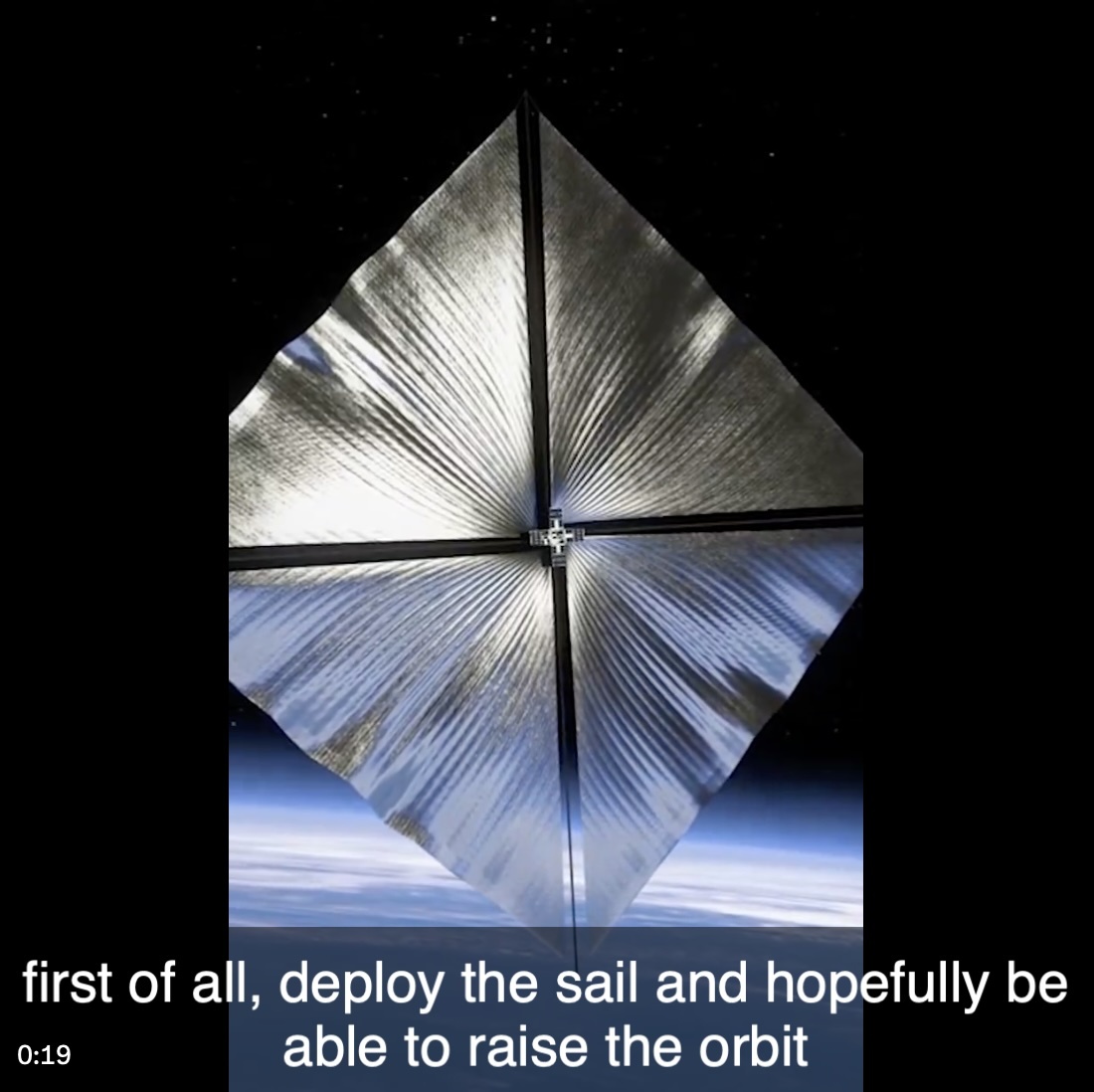NASA Ames manages the Advanced Composite Solar Sail System project and designed and built the onboard camera diagnostic system. NASA Langley designed and built the deployable composite booms and solar sail system. NASA’s Small Spacecraft Technology (SST) program office based at NASA Ames and led by the agency’s Space Technology Mission Directorate (STMD), funds and manages the mission. NASA STMD’s Game Changing Development program developed the deployable composite boom technology. Rocket Lab USA, Inc of Long Beach, California is providing launch services. NanoAvionics is providing the spacecraft bus.
22.04.2024

Come sail away... with the power of the Sun! Tomorrow, April 23 (April 24 in New Zealand),
NASA Next-Generation Solar Sail Boom Technology Ready for Launch
Sailing through space might sound like something out of science fiction, but the concept is no longer limited to books or the big screen. In April, a next-generation solar sail technology – known as the Advanced Composite Solar Sail System – will launch aboard Rocket Lab’s Electron rocket from the company’s Launch Complex 1 in Māhia, New Zealand. The technology could advance future space travel and expand our understanding of our Sun and solar system.
Solar sails use the pressure of sunlight for propulsion, angling toward or away from the Sun so that photons bounce off the reflective sail to push a spacecraft. This eliminates heavy propulsion systems and could enable longer duration and lower-cost missions. Although mass is reduced, solar sails have been limited by the material and structure of the booms, which act much like a sailboat’s mast. But NASA is about to change the sailing game for the future.
NASA’s New Lightweight Sailor
The Advanced Composite Solar Sail System demonstration uses a twelve-unit (12U) CubeSat built by NanoAvionics to test a new composite boom made from flexible polymer and carbon fiber materials that are stiffer and lighter than previous boom designs. The mission’s primary objective is to successfully demonstrate new boom deployment, but once deployed, the team also hopes to prove the sail’s performance.
Like a sailboat turning to capture the wind, the solar sail can adjust its orbit by angling its sail. After evaluating the boom deployment, the mission will test a series of maneuvers to change the spacecraft’s orbit and gather data for potential future missions with even larger sails.
“Booms have tended to be either heavy and metallic or made of lightweight composite with a bulky design – neither of which work well for today’s small spacecraft. Solar sails need very large, stable, and lightweight booms that can fold down compactly,” said Keats Wilkie, the mission’s principal investigator at NASA’s Langley Research Center in Hampton, Virginia. “This sail’s booms are tube-shaped and can be squashed flat and rolled like a tape measure into a small package while offering all the advantages of composite materials, like less bending and flexing during temperature changes.”

After reaching its Sun-synchronous orbit, about 600 miles (1,000 kilometers) above Earth, the spacecraft will begin unrolling its composite booms, which span the diagonals of the polymer sail. After approximately 25 minutes the solar sail will fully deploy, measuring about 860 square feet (80 square meters) – about the size of six parking spots. Spacecraft-mounted cameras will capture the sail’s big moment, monitoring its shape and symmetry during deployment.
With its large sail, the spacecraft may be visible from Earth if the lighting conditions are just right. Once fully expanded and at the proper orientation, the sail’s reflective material will be as bright as Sirius, the brightest star in the night sky.
“Seven meters of the deployable booms can roll up into a shape that fits in your hand,” said Alan Rhodes, the mission’s lead systems engineer at NASA’s Ames Research Center in California’s Silicon Valley. “The hope is that the new technologies verified on this spacecraft will inspire others to use them in ways we haven’t even considered.”

Enabling Future Solar Sails
Through NASA’s Small Spacecraft Technology program, successful deployment and operation of the solar sail’s lightweight composite booms will prove the capability and open the door to larger scale missions to the Moon, Mars, and beyond.
This boom design could potentially support future solar sails as large as 5,400 square feet (500 square meters), about the size of a basketball court, and technology resulting from the mission’s success could support sails of up to 21,500 square feet (2,000 square meters) – about half a soccer field.
“The Sun will continue burning for billions of years, so we have a limitless source of propulsion. Instead of launching massive fuel tanks for future missions, we can launch larger sails that use “fuel” already available,” said Rhodes. “We will demonstrate a system that uses this abundant resource to take those next giant steps in exploration and science.”
Because the sails use the power of the Sun, they can provide constant thrust to support missions that require unique vantage points, such as those that seek to understand our Sun and its impact on Earth. Solar sails have long been a desired capability for missions that could carry early warning systems for monitoring solar weather. Solar storms and coronal mass ejections can cause considerable damage on Earth, overloading power grids, disrupting radio communications, and affecting aircraft and spacecraft.
Composite booms might also have a future beyond solar sailing: the lightweight design and compact packing system could make them the perfect material for constructing habitats on the Moon and Mars, acting as framing structures for buildings or compact antenna poles to create a communications relay for astronauts exploring the lunar surface.
“This technology sparks the imagination, reimagining the whole idea of sailing and applying it to space travel,” said Rudy Aquilina, project manager of the solar sail mission at NASA Ames. “Demonstrating the abilities of solar sails and lightweight, composite booms is the next step in using this technology to inspire future missions.”
NASA Ames manages the Advanced Composite Solar Sail System project and designed and built the onboard camera diagnostic system. NASA Langley designed and built the deployable composite booms and solar sail system. NASA’s Small Spacecraft Technology (SST) program office based at NASA Ames and led by the agency’s Space Technology Mission Directorate (STMD), funds and manages the mission. NASA STMD’s Game Changing Development program developed the deployable composite boom technology. Rocket Lab USA, Inc of Long Beach, California is providing launch services. NanoAvionics is providing the spacecraft bus.
Quelle: NASA
----
Update: 25.04.2024
.
NASA's CubeSat Solar Sail Successfully Unfurls in Orbit

NASA's Advanced Composite Solar Sail System (ACS3) has successfully deployed from Rocket Lab's Electron kick stage into low Earth orbit. The mission, which utilizes sunlight for propulsion, is a key demonstration of next-generation solar sail technology.
Following deployment, the Solar Sail CubeSat will power up and begin its initial communication attempts with ground control. These efforts are expected to occur overnight or in the coming days as the satellite settles into its orbit.
The mission launched from Rocket Lab's Electron rocket, carrying the ACS3 CubeSat equipped to test its innovative solar sail. This technology harnesses sunlight directly for propulsion, akin to wind propelling a sailboat.
The purpose of this mission is to advance solar sail technologies, which are essential for future deep space exploration. Solar sails, such as the one used by ACS3, leverage the momentum of photons from the sun to move through space, thus eliminating the need for traditional rocket fuels. The ACS3 employs composite materials for its construction, featuring lightweight booms made from a carbon fiber-reinforced polymer. These booms extend to form a large sail, which will harness solar radiation for propulsion.
The primary goal for this mission is the successful deployment and operation of the solar sail in orbit. Once in space, ACS3 will deploy its solar arrays and initiate the unfurling of its sail via four diagonal booms, each extending to approximately 23 feet (7 meters). This deployment is expected to take about 25 minutes, resulting in a square-shaped sail measuring 30 feet (9 meters) on each side.
The booms of ACS3, crucial for maintaining the sail's shape and alignment, are designed to withstand the harsh conditions of space, including extreme temperature variations that can cause materials to warp or bend. The robustness of the design is intended to ensure that the sail operates efficiently and can continue to do so indefinitely, constrained only by the durability of its materials and onboard electronics.
This technology demonstration is part of NASA's broader strategy to explore solar sailing as a viable alternative to conventional propulsion methods, which could revolutionize the design and flexibility of future spacecraft for a variety of mission objectives.
Quelle: SD
----
Update: 3.05.2024
.
Ahoy! NASA’s Solar Sail Mission Successfully Phones Home

NASA’s Advanced Composite Solar Sail System has now connected with ground operators following its April 23 launch aboard Rocket Lab’s Electron rocket. The satellite is on its way to testing next-generation solar sail technology, which uses the power of sunlight to propel a spacecraft. The results from this mission will advance future space travel to expand our understanding of our Sun and solar system.
The spacecraft was successfully delivered to a type of low Earth orbit called a Sun-synchronous orbit. All systems show that the spacecraft is operational and healthy. Last night at 11:30 p.m. PDT (2:30 a.m. EDT), the microwave oven-sized CubeSat passed over the ground hub located at Santa Clara University’s Robotics Systems Lab in Santa Clara, California, and the mission team confirmed successful two-way communications.
Next, the CubeSat will undergo a one- to two-month commissioning phase to prepare for the solar sail deployment and maneuvering test. At this time, the sail remains within the body of the CubeSat. The mission operations team will set a date to unfurl the sail after all commissioning tasks have been completed. Once ready, the spacecraft will unroll it solar sail via four booms that span the diagonals of the square and unspool to reach 23 feet (about 7 meters) in length.
